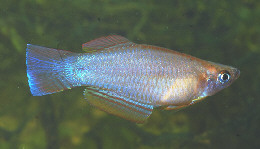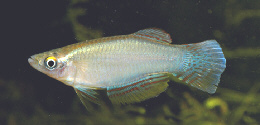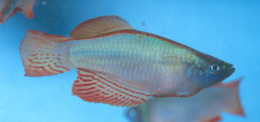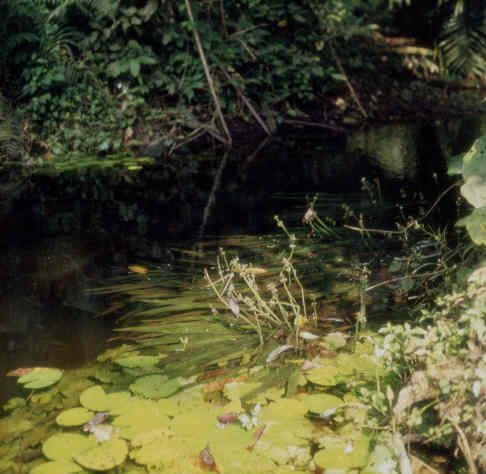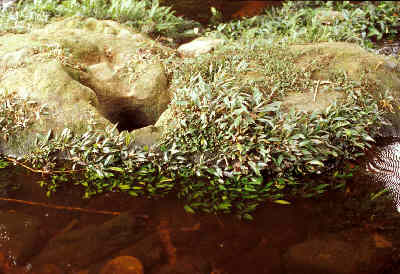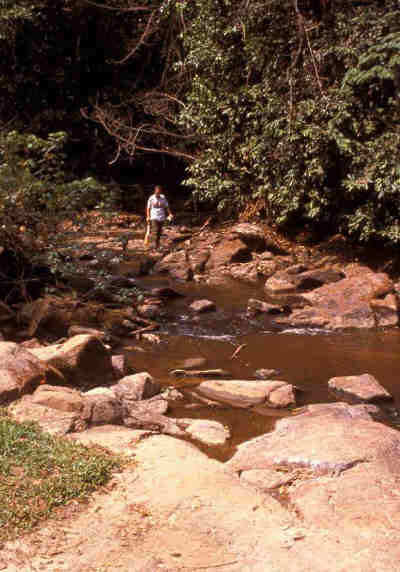Procatopus nototaenia Boulenger 1904

Kribi, Cameroon. Photo: Courtesy of Ed Pürzl
| Meaning of Name |
Procatopus means anterior lower opening. This refers to the anus situated to the rear of the body. nototaenia refers to the red band on the back of the body. |
||||||||||||||||||
| First Description |
Boulenger G.A. 1904 Descriptions of New West African Freshwater Fishes. Journal Ann. Mag. nat. Hist., (14) 7 (79) 1904, d. pp 16-20. |
||||||||||||||||||
| Size |
Males 6 cm, females 4·5 cm. |
||||||||||||||||||
| Meristics |
D = 8-11, A = 15-18, ll = 27-29. |
||||||||||||||||||
| Karyotype |
n=24 |
||||||||||||||||||
| Sub-Genus | |||||||||||||||||||
| Group | |||||||||||||||||||
| Synonyms |
Procatopus glaucicaudis
Clausen 1959 - Collected by Clausen from a stream in the Cross river
drainage 93 kms north of Kumba. Radda collected in a stream near Baduma
in the Mungo river system (probably Wowe or Moliba). |
||||||||||||||||||
Populations
|
Commercial Imports - Many fish of this species have been imported from commercially caught fish.
Fifinda
- CBL 01 / 15, collected north of the Lokoundjé in a stream
called the Fifinda in February 2001 by Olivier Buisson & Patrice
Lambert. Two males & three females survived the journey back to
aquaria. This is in the Lokoundjé
drainage. Collected under the bridge on the
road between Douala & Kribi in the Stream Fifinda. This is actually
a large stream/river which flows directly into the sea. Kribi -
Kopongo -
Yabassi - A population which can appear yellowish in some lights & bright shining blue in others. The red/orange band on the back is less pronounced.
CCPT 84 / 11 - Collected near Mbébé on the road between Londji & Edéa in a stream draining into the Nyong River. This is north of the Fifinda collections. This collection is reportedly having an orange reflection in the body & stripes in the fins. The anal has no extensions. This may be a population of P.similis. |
||||||||||||||||||
| Type Locality |
Lobi river, south Cameroon. |
||||||||||||||||||
| Distribution |
Kellé, Lokoundjé, Lobé, Kienke & Ntem River drainages. |
||||||||||||||||||
| Habitat |
Prefers clear moving water over
a stony base several metres wide. Water is soft & slightly acidic
being often brownish in colour. They have been collected in various
temperatures from 70-85°F.
See also A.ahli for biotope photo. |
||||||||||||||||||
| Distinguishing Characteristics | Difficult to tell this species apart from P.similis. P.nototaenia is seperated in some literature by the anal fin extensions & the red line along the back. Also a straighter back. However, some populations of P.similis can show these characteristics. | ||||||||||||||||||
| Colour/Pattern Variability | |||||||||||||||||||
| History |
Boulenger gives the following collectors / locations in his 1915 Catalogue.
Possibly first introduced into the BKA around April 1966. See BKA newsletter No.9. Also imported in 1967. See BKA newsletter No.20. |
||||||||||||||||||
| Breeding Notes |
Breeding is a little different to other West
African killies. They lay eggs in tight nooks & crannies. Various
mediums have been used. Olivier Buisson wrote an article in BKA newsletter
N.540, Jan/Feb 2011 where he used small plastic mesh rolled up into
a tube around a mop & tied together. For this you can use greenhouse
shading material which can be bought cheaply off the roll. This tube
can be removed & eggs taken off. However, this handling can cause
many eggs to fungus. |
||||||||||||||||||
| Diameter of Egg | |||||||||||||||||||
| Remarks |
Olivier Buisson remarked on some diseases he encountered with his collections. The mouth can be prone to fungus. Also the anal part of the body turns translucent white. Swimming became 'wave like' & resperation increased. Death would follow. Sometimes this would vanish but return after a few weeks. |






